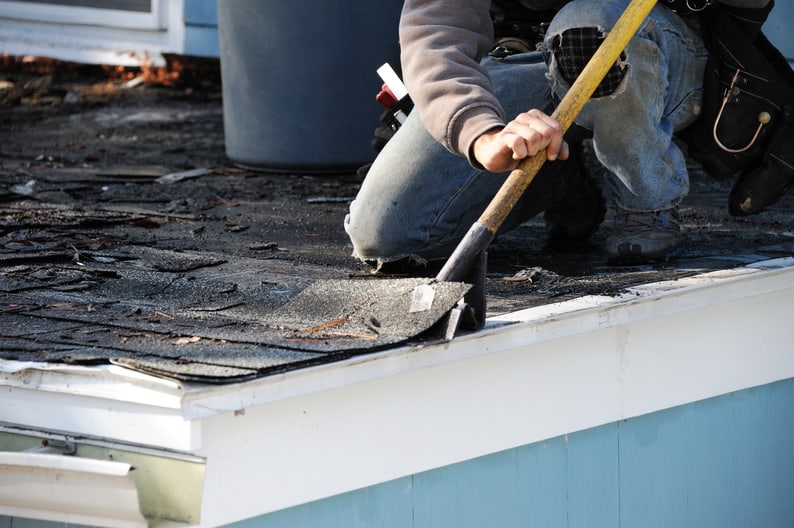
When your roof is in need of repair, it can be tempting to climb up and fix it right away. But there are many safety precautions that should be taken to avoid the hazards involved with roof repair.
In the United States, there are more than 300 deaths and 164,000 emergency room visits every year due to falls from ladders. So to make Bay Area roofers and homeowners a little safer, we’re giving you our complete roof repair safety guide.
The Roof Repair Safety Guide
Assess your work area
Before you do anything, it’s important to get familiar with your work area. Start by blocking children and pets from the area, then take a walk around the site. Look for potential hazards such as:
- power lines
- unsafe roof access areas
- uneven terrain
- underground structures
- debris
Also be mindful of your working conditions. Don’t work on your roof if it’s wet and slippery, excessively windy, or if the temperatures are extreme. If it’s too hot or cold when you make a repair, your handiwork can become warped or otherwise not seal properly.
Get the right equipment
When you’re ready to go up on the roof, you’ll need a sturdy extension ladder. You can buy them for around $200 or rent one for approximately $30 a day. Just make sure it extends a minimum of three feet above the edge of your roof.
Fiberglass ladders are heavier and more unwieldy than aluminum ones. However, they offer better protection against electrocution in the event that the ladder accidentally touches a live wire. If there’s a power line anywhere near your home, fiberglass ladders are the only way to go.
Invest in your safety
Trips, slips, and falls are the most dangerous part of roof repair. Consider purchasing roof brackets to reduce your risk of a serious accident. When properly installed, they make it easier to safely move around the roof, provide a convenient place to rest your tools, and act as a slide guard to catch you in the event of a slip.
If you’re working on a particularly steep or high roof, a safety harness is necessary. It fastens snugly around your chest and is secured to an anchor on the roof with rope. Harnesses ensure the safest conditions to perform roof repairs.
Properly install your ladder
Navigating ladders is one of the trickier aspects of roof repair. Always refer to the manufacturer’s instructions when putting up a ladder and read all safety guidelines included in the packaging. Never use a ladder that’s damaged.
When possible, put your ladder on firm, even ground. If the ground is moist from recent rain, wait until it’s firm again before trying to access your roof. Otherwise, if the ground is not level, cut pieces of plywood and put them underneath one side to even out the base of your ladder.
Secure the ladder base with stakes and rope. When you reach the top, secure the top of your ladder to the roof using an anchor to prevent it from sliding. Always use care when moving between the ladder and roof.
Moving between the ladder and the roof
Don’t try to carry tools or equipment up or down the ladder on your own. Instead, use a bucket and rope to hoist tools up or down when you’re already safely on the roof. Your hands are for climbing.
As mentioned before, your ladder should extend a minimum of three feet above your roof. But don’t step on rungs that extend past the roof. Instead, use them as handholds when carefully stepping on and off the roof.
Dress for the job
If you’re going on the roof, traction is everything. Wear flat, soft-soled shoes to get the best grip and always clear dirt and mud from your shoes before ascending the ladder. Likewise, keep your roof free of debris.
Wear clothing that’s comfortable, but avoid anything baggy. The extra fabric is at risk of getting caught on things like the top of the ladder or old nails in your roof. Cover up your skin as much as you can to protect yourself against the sun and the coarse texture of the roof.
Finally, do yourself a huge favor, and pick up some knee pads! Most of the work will likely require you to kneel, and a cheap set of knee pads will literally save your skin.
Keep your tools handy (and secure)
Be extremely cautious when holding anything on the roof. Your supplies and tools can do some serious damage if they slip and hit someone below. That’s why it’s vital to secure your tools as best you can whenever they’re not in use.
Hand tools can be can stored in a bucket or bag and secured to an anchor or roof bracket. Likewise, power tools can be anchored to the roof with bungee cords or rope. Just stay aware of where your ropes are situated–they’re a major tripping hazard.
Keep passersby safe
Use rope, tape, and signage to mark the ground under your work area and inform people that you’re working above. No matter how cautious you are, accidents happen (and tools fall). Similarly, always check that the area is clear before you toss anything off the roof.
Know When to Call the Roof Repair Pros
Roof repairs aren’t easy and there are a number of safety considerations to keep in mind before undertaking one on your own. Overall, it comes down to common sense. If something seems unsafe, it probably is.
While this roof repair safety guide is handy for homeowners, most of the time roof repair is best left to professionals. For example, if you assess your area and find that the roof is very steep, high, or difficult to access, call a professional. The risk of death or disability just isn’t worth it.
Likewise, major tile and slate repairs should not be done by inexperienced roofers. Basic tile roof maintenance is one thing, but these types of roofs are easily damaged and run the risk of falling when they’re loose.
But hey–now that you know how to safely repair your roof, why not look into solar panels? They’re a great way to invest in your home and lower your energy costs.

